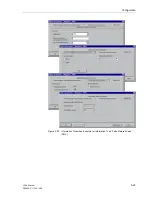
Configuration
5-33
7SA6 Manual
C53000-G1176-C156-2
Please be aware of the fact that also pickups from the overload protection or the
sensitive earth current supervision can cause and maintain a fault and therefore
block a close command. When resetting the interlocking also take into considera-
tion that the automatic reclosure lockout for motors in this case does not automati-
cally negate a close command sent to the motor. The automatic reclosure must then
be interlocked differently, e.g. via bay specific interlocking with CFC.
•
Double operation: Parallel switching operations are blocked with respect to each
other: while one switching operation is being conducted, a second one cannot be
performed.
•
Switching Authority – Local Commands: A local control switching command is only
allowed if local control is enabled on the relay (via lockswitch or setting).
•
Switching Authority – Remote Commands: A remote control switching command is
only allowed if remote control is enabled on the relay (via lockswitch or setting).
Configuring a LED
Display as a Desti-
nation
Up to 30 single point indications (SP), output indications (OUT), and internal single
point indications (IntSP) may be assigned to LEDs. One indication may be assigned
to a maximum of 10 outputs which includes LEDs and output relays (cf. also margin
header “Configuring Binary Outputs as a Destination” on page 5-30).
When doing this, you may select whether the indications are to be latched (
L
) or un-
latched (
U
). If you select latched, the assigned LED remains energized, even after the
indication is no longer present. It must be manually reset by pressing the “LED” Reset
button on the front panel of the device, or via a binary input with the indication function
“
>LED Reset
”, or via the serial system interface.
Configuring an
Indication Buffer
as a Destination
A maximum of three indication buffers may be available for messages: Operation
(Event Log) Buffer (
O
), Fault (Trip Log) Buffer (
T
) and Earth Fault Message Buffer (E).
The indications from protective functions are firmly assigned to these indication buff-
ers. For the others, Table 5-2 provides an overview of which indication type may be
configured to which buffer.
Select one of the following options for the named indication types:
•
O
(on or coming) – the indication is stored in the buffer with the time of its arrival
•
OO
(on/off or coming/going) – the indication is stored in the buffer with the time of
its arrival and departure
•
_
(not configured) – the indication is not stored in a buffer.
Table 5-2
Overview of Indication Buffers
Information Type
↓
\Message Buffer
→
O
E
T
Single Point Indications (SP)
X
X
X
Double Point Indications (DP)
X
Output Indications (OUT)
X
X
X
Internal Single Point Indications (IntSP)
X
X
X
Internal Double Point Indications (DP)
X
Transformer Tap Indication (TxTap)
X
Summary of Contents for siprotec 7SA6
Page 2: ...Siemens Aktiengesellschaft Book No C53000 G1176 C156 2 ...
Page 18: ...xviii 7SA6 Manual C53000 G1176 C156 2 ...
Page 32: ...Introduction 1 14 7SA6 Manual C53000 G1176 C156 2 ...
Page 82: ...Hardware and Connections 2 50 7SA6 Manual C53000 G1176 C156 2 ...
Page 119: ...SIPROTEC 4 Devices 4 25 7SA6 Manual C53000 G1176 C156 2 Figure 4 20 CFC Logic example ...
Page 190: ...Configuration 5 62 7SA6 Manual C53000 G1176 C156 2 ...
Page 652: ...Installation and Commissioning 8 78 7SA6 Manual C53000 G1176 C156 2 ...
Page 724: ...Technical Data 10 56 7SA6 Manual C53000 G1176 C156 ...
Page 800: ...Appendix A 76 7SA6 Manual C53000 G1176 C156 2 ...
Page 866: ...Appendix B 66 7SA6 Manual C53000 G1176 C156 2 ...
















































